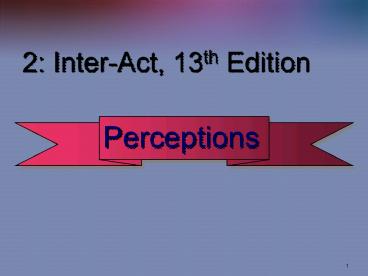Perceptions - PowerPoint PPT Presentation
Title:
Perceptions
Description:
2: Inter-Act, 13th Edition Perceptions * * Social Perception Also known as cognitive perception, it is the set of processes by which people perceive themselves ... – PowerPoint PPT presentation
Number of Views:282
Avg rating:3.0/5.0
Title: Perceptions
1
2 Inter-Act, 13th Edition
Perceptions
2
Social Perception
Also known as cognitive perception, it is the
set of processes by which people perceive
themselves and others.
3
Perception
The process of selectively attending to,
organizing, and interpreting the information that
we receive through our senses
4
Attention Selection
Organization
Interpretation
5
Attention and Selection
- Selection is determined by
- Our needs
- Our interests
- Our expectations
6
Organization
- Simplicity the brain reduces complex stimuli
into recognized forms - Pattern recognition the brain organizes
information into recognizable patterns or systems
of interrelated parts
7
Interpretation
The process of assigning meaning to the
information that has been selected and organized
8
Dual Processing in Perception
- Automatic processing
- Fast, subconscious
- Heuristics rules of thumb for how something is
to be viewed based on experience - Conscious processing
- Slow, deliberative approach
- We examine and think about the stimuli
9
Perceiving Others
Uncertainty reduction theory ways individuals
monitor their social environments to know more
about themselves and others
10
Impression Formation
Physical appearance predictions based on
appearance Implicit personality theory
inaccurate perceptions based on the association
of physical or other characteristics with
personality traits Assumed similarity thinking
that others who share one characteristic with you
also share others
11
Attributions
Attributions reasons we give for our own and
others behavior Situational attribution
attributing behavior to an external situation,
outside of a persons control Dispositional
attribution attributing behavior to someones
internal disposition or personality
12
Person-Perception Biases
Person-Perception Biases selective perception,
stereotyping, halo effects, forced consistency,
projection, and fundamental attribution error
Selective Perception inaccurately paying
attention only to what we expect to see or hear
and ignoring what we dont expect
13
Stereotyping
Prejudice stereotyping based on the
characteristics of a persons group
Discrimination acting differently toward a
person based on prejudice
Racism, Ethnocentrism, Heterosexism, Sexism,
Ageism, Able-ism belief that the behaviors or
characteristics of one group are inherently
superior to those of another
14
More Biases
Halo effects thinking a person has a whole set
of related personality traits when only one trait
has actually been observed
Forced consistency interpreting conflicting
different perceptions of another person so our
interpretation of what we see remains consistent
Projection thinking that someone who is like us
in one respect will share other characteristics
and attitudes
Fundamental attribution error ascribing
others negative behavior to their dispositions
while ascribing our negative behavior to the
situation
15
Improving Social Perceptions
- Question the accuracy of perceptions.
- Seek more information.
- Use conscious processing.
- Realize that perceptions change.
- Use perception checking.
16
Self-Perception
Self-concept your perception of your
competencies and personality traits
Self-esteem your evaluation of your perceived
competence and personal worthiness
17
Cultural Self-Perception
Independent self-perception viewing traits,
abilities, and personality as internal and
universally applicable Interdependent
self-perception viewing traits, abilities, and
personality as dependent upon the situation
18
Positive Self-Esteem
Perception of having a characteristic
Personal belief that the characteristic is of
positive value Positive self-esteem
-Mruk
19
Accuracy of Self-Concept and Self-Esteem
- Incongruence gap between self-perception and
reality - Self-fulfilling prophecies events that happen as
the result of being foretold, expected, or talked
about - Filtering messages paying attention only to
messages that reinforce our current self-concept
20
Self-Perception and Communication
Our self-perception affects our communication by
influencing our messages to/about ourselves and
to/about others.
21
Self-Perception Online
- How comfortable are you with. . .
- Digital self-disclosure?
- Digital social connection?
- Convenience?
- Digital apprehension?
- Miscommunication?
- Online communication attitudes influence how much
you communicate through social media.
22
Social Media the Human Factor
- Self-disclosure provides opportunities for
connection. - Remember that miscommunication can occur.
- Convenience is both an opportunity and a
challenge.































